An astounding 80% of marine pollution originates not from the ocean’s natural processes but rather from activities conducted on land. The ocean’s surface beauty stands in stark contrast to an underlying crisis. This crisis, characterized by widespread water pollution, severely threatens the rich diversity of marine life. Predominantly, this pollution manifests in both macroscopic and microscopic plastics, emblematic of the daunting environmental challenge our oceans face due to contemporary human practices.
Plastic waste represents merely the outset of a more complex issue. Compounded by agricultural runoff, unchecked sewage disposal, and pollutants from maritime activities, these sources exacerbate the degradation of marine ecosystems. Furthermore, terrestrial runoff and atmospheric deposition pollutants contribute to the ocean’s plight, emphasizing the necessity for comprehensive intervention strategies. Notably, nations such as China, Indonesia, and the Philippines have been identified as primary contributors to oceanic plastic discharge. This underscores the urgent need for an integrated international approach to mitigating marine pollution.
Key Takeaways
- Understanding the types and causes of ocean pollution is paramount in addressing the crisis.
- Plastic pollution, including microplastics, poses a serious threat to marine health.
- Land-based activities significantly contribute to the majority of water pollution.
- Effective pollution solutions require widespread ocean conservation efforts and regulation.
- Progress toward ocean pollution prevention is achievable through informed global collaboration.
Understanding Ocean Pollution and Its Far-Reaching Effects
The environmental impact of ocean pollution represents a pressing global concern with far-reaching implications for marine ecosystems and planetary health. Pollutants infiltrating our oceans have catastrophic consequences for marine fauna and human communities, underscoring the imperative for in-depth understanding and prompt action to mitigate the environmental degradation of aquatic realms.
The Definition of Marine Pollution and its Diversity
Marine pollution manifests through the discharge of harmful substances like chemicals, plastics, and synthetic materials into marine ecosystems. Originating primarily from land-based sources, this pollution is characterized by various harmful agents that corrupt our oceans. These pollutants, encompassing nonpoint sources from urban runoff to agricultural outputs and transportation, intertwine to form a complex contamination web. Furthermore, substances such as PFAS, known for their enduring presence and resistance to natural decomposition, augment the toxic amalgam.
Impact and Ocean Pollution Statistics
Ocean pollution statistics unveil a distressing reality, indicating significant, multifaceted impacts on marine organisms. Marine debris, comprising microplastics to abandoned fishing implements, endangers myriad species worldwide. Disturbing data demonstrate how pollution, notably plastic, infiltrates even the most secluded areas of the ocean and the abyssal depths, forming extensive garbage patches within global gyres. The accumulation of harmful substances like heavy metals in seafood harbors profound health implications for humans, whereas carbon emissions-induced ocean acidification disrupts the fragile marine food web.
The table below elucidates a spectrum of pollutants alongside their repercussions on ocean vitality:
| Pollutant | Source | Impact on Marine Ecosystems | Human Health Risks |
|---|---|---|---|
| Plastic Waste | Land-based sources, single-use items | Endangers marine species forms garbage patches | Contaminates food chain with microplastics |
| Nutrient Runoff | Agriculture, urbanization | Creates harmful algal blooms and hypoxic zones | Compromises seafood safety and water quality |
| PFAS | Industrial processes, consumer products | Pollutes water, resistant to degradation | Linked to a range of health concerns |
| Heavy Metals | Industrial waste, contaminated runoff | Accumulates in marine life, threatens biodiversity | Increases risk of seafood-related illnesses |
| Carbon Emissions | Fossil fuel use, deforestation | Causes acidification, disrupts carbonate levels | Threatens industry, food security |
Initiatives from entities like NOAA, community-focused events such as Baltimore’s B’more Conscious, and legislative efforts banning single-use plastics signify a growing global endeavor to combat oceanic degradation. This escalating environmental crisis afflicting our marine ecosystems highlights a collective obligation to mitigate the effects of ocean pollution on marine biodiversity and to ensure the preservation of our oceans’ health.
Plastic Pollution in Oceans: The Leading Threat to Marine Health
The plastic pollution crisis pervading marine environments requires collaboration among scientists, environmentalists, and legislators for effective marine pollution mitigation strategies. Common products such as plastic bags and bottles degrade marine habitats, demonstrating the impact of pollution on marine life and necessitating urgent action.
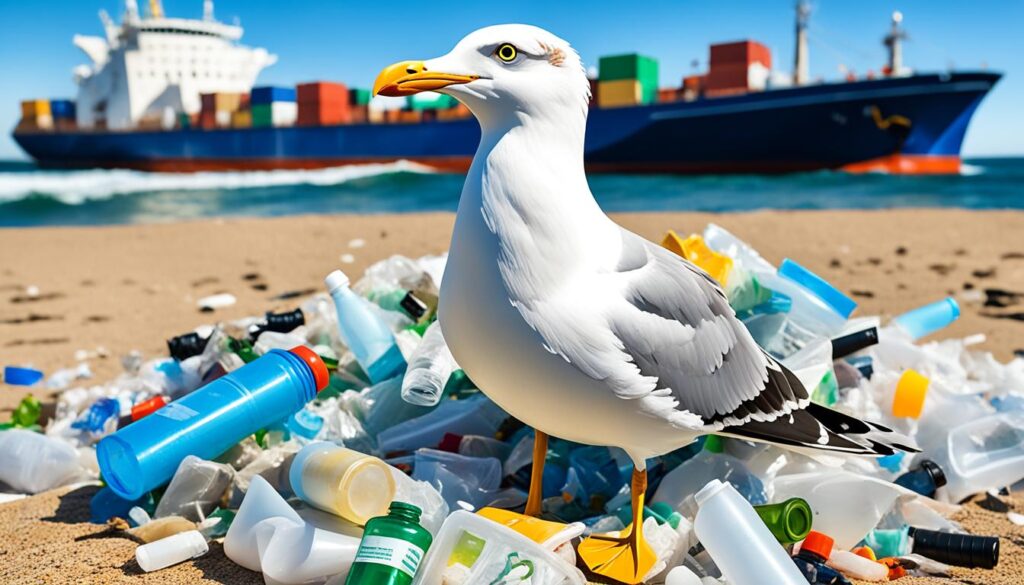
From Bags to Bottles: Identifying Common Plastic Culprits
The proliferation of plastic waste is primarily attributed to disposable items like grocery bags, water bottles, straws, and takeaway containers. The widespread use of these items highlights the critical necessity for robust plastic waste management frameworks. Inadequate disposal methods enable plastics to infiltrate ecosystems, eventually drifting into oceanic realms.
The Lifecycle of Plastic Waste in Marine Environments
Plastic debris instigates a protracted ecological disruption across marine ecosystems upon incarnating into the oceanic domain. Materials such as plastic bags persist for hundreds of years before fragmenting, ensuring a continuing adverse influence on marine biodiversity as they transform into microplastics that marine species inadvertently ingest.
Insights from NOAA’s educational resources underscore the importance of preventative strategies and heightened awareness in combating plastic pollution.
Majority of marine debris is terrestrial in origin, propelled into oceanic realms through acts of littering, deficient waste management practices, and natural occurrences.
| Source of Pollution | Impact on Marine Life | Health Risks |
|---|---|---|
| Microplastics | Ingested by numerous marine species | Accumulates in seafood, posing potential health threats to humans |
| Derelict Fishing Gear | Causes entanglement and potential fatality among marine species | – |
| Abandoned Vessels | Results in Habitat Degradation | – |
| Garbage Patches | Alters the natural mechanics of ocean gyres | Introduces contaminants and heavy metals into the marine food chain |
| Nonpoint Source Pollution | Promotes Harmful Algal Blooms and hypoxia | Introduces PFAS chemicals into water, which are resistant to biodegradation |
Chemical Contamination: Nutrient Pollution’s Dire Consequences
The escalating crisis of chemical contamination in aquatic environments finds its origins entwined with nutrient pollution. This principal factor in water contamination arises from the indiscriminate use of nitrates and phosphates, significantly from agricultural runoff. This causes a cascade effect across ecosystems, impacting freshwater and saltwater bodies. Disturbingly, approximately half of U.S. rivers and streams are now polluted to a degree that precludes their basic functions. Furthermore, nearly 40 percent of Americans rely on groundwater, which faces escalating contamination risks.
Ocean pollution’s impacts emerge gradually but are profoundly debilitating. Research indicates that eighty percent of marine pollution originates on land. The primary culprit behind water contamination in the U.S. is nonpoint source pollution. It eludes conventional treatment systems before it flows into our water bodies and, subsequently, the ocean.
Alarming data elucidates both an urgent environmental and health crisis. Over a third of the U.S. freshwater resources are in lakes, now bearing the brunt of nutrient pollution. This leads to algal blooms that strip oxygen from water, rendering vast areas into lifeless “dead zones.”
Nutrient saturation in aquatic sources precipitates an environmental disaster and an economic calamity. It jeopardizes the sustainability of both fisheries and tourism, illustrating a ripple effect. This emanates from microscopic nutrient levels, impacting broad socio-economic frameworks.
Sources of Ocean Pollution: From Land to Sea
The causes of marine pollution originate predominantly from human activities, extending from coastal areas into inland regions. A particularly insidious contributor is non-point source pollution, encompassing pollutants from widespread, often indistinct sources. This variety of water pollution proves challenging to mitigate, given its absence of a singular, identifiable source.
Runoff and Nonpoint Source Pollution Explained
Runoff, ensuing chiefly from rain or snowmelt, transports various pollutants from terrestrial to aquatic environments. This runoff can transport agricultural chemicals, such as nitrogen and phosphorus, that induce harmful algal blooms alongside urban runoff laden with per- and polyfluoroalkyl substances (PFAS). These substances detrimentally impact marine ecosystems, frequently culminating in ‘dead zones’ devoid of marine life.
Intentional Discharges and Their Regrettable Aftermath
Intentional discharges present another mechanism of ocean pollution causes, characterized by the direct introduction of waste, including toxic industrial byproducts, into waterways. Despite regulatory efforts, these discharges persist, further aggravating ocean pollution challenges.
| Pollutant Type | Examples | Effects on Marine Life | Longevity in Environment |
|---|---|---|---|
| Plastics/Microplastics | Bags, bottles, fishing gear | Entanglement, ingestion | Up to hundreds of years |
| Chemicals | Nitrogen, phosphorus, PFAS | Harmful algal blooms, bioaccumulation | Varies, PFAS are resistant to degradation |
| Marine Debris | Derelict vessels, abandoned gear | Physical hazards, habitat destruction | Decades to indefinitely |
| Garbage Patches | Accumulated trash in gyres | Ecological imbalance, contamination | Continuously aggregating |
In the United States, a critical one-third of the waters designated for shellfish cultivation suffers from coastal pollution. This stands as a testament to marine pollution’s ecological and significant economic ramifications. Initiatives like the NOAA Marine Debris Program are crucial in educating about the extensive nature of ocean pollution causes and fostering actionable solutions.
The Alarming Issue of Industrial and Oil Pollution
The unremitting expansion of industrial activities alongside the frequency of oil spills has manifested an adverse reality for marine health. As they increase, industries invariably escalate the volume of industrial and oil pollution. This progression underscores the urgency of ocean cleanup efforts. Astoundingly, projections suggest that annually, between 22 million and 58 million tons of waste could imminently invade waterways and oceans, rendering the mitigation of marine debris an increasingly formidable challenge.
Deep-Sea Consequences of Oil Spills
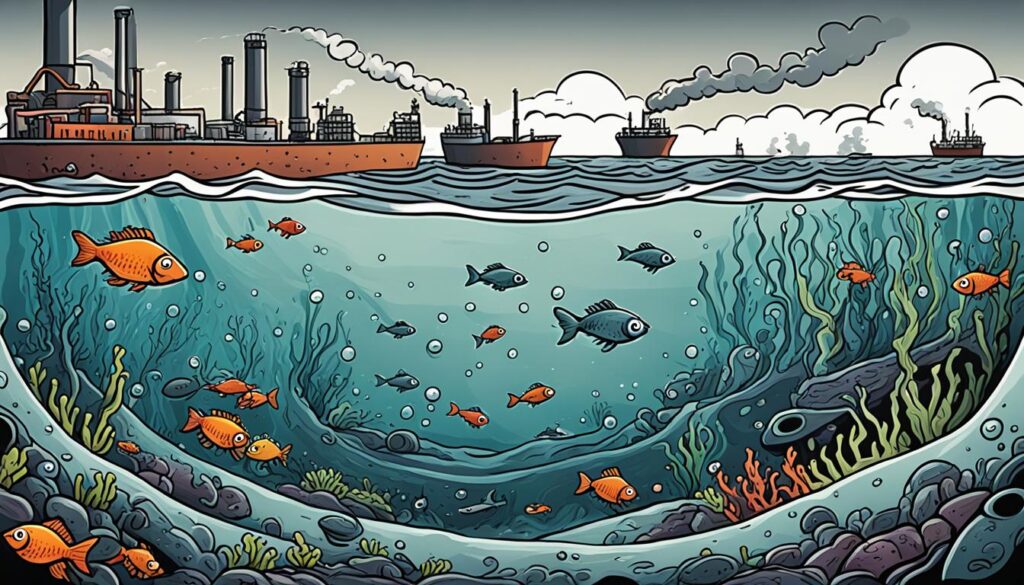
Reflecting on oil spills, one must recall historic disasters like the Deepwater Horizon spill, which underscores the severity of potential damages. These events have discharged approximately 134 million gallons of oil into the marine environment, generating long-lasting toxicity, reduced mobility, and reproductive challenges across numerous species. The consequences of such disasters are enduring, significantly obstructing marine debris reduction and ecosystem restoration endeavors.
Industrial Waste: A Toxic Legacy for Oceans
The issue of industrial waste represents a relentless contribution to the toxic legacy our oceans inherit. Mercury, among other hazardous substances, permeates marine ecosystems, inflicting sustained damage. With plastic production on track to more than double by 2050, deploying effective disposal and ocean cleanup mechanisms is imperative. Without these, an estimated 99 million tons of plastic waste may find its way into the oceans by 2030, uncontrolled and devastating.
The data reveals an alarming trend in plastic production, escalating from 1.8 million tons in the 1950s to 465 million tons in contemporary times. This surge, fueled by projected demographic growth and middle-class expansion in Asia and Africa, hints at an inevitable increase in waste. Such growth demands preemptive action. Remarkably, the United States has allocated $203 billion towards enhancing plastic production capacity through new and expanded chemical plants. This fact lays bare a critical dichotomy between market dynamics and the imperative of environmental stewardship.
The need for innovative management strategies becomes evident in contemplating the complexities posed by industrial pollution and oil spills. Our shared vision for sustainability compels us to lighten the load of marine debris on our oceans. Achieving ecological balance and ensuring the vitality of marine ecosystems for future generations requires establishing new paradigms. We can only halt the decline and pave the way toward ecological restoration and balance through concerted effort.
Marine Debris Beyond Plastics: Other Pollutants in Our Oceans
The discourse surrounding marine litter often focuses on plastic, yet many other substances also preside over the ocean debris quandary. Among these, abandoned fishing apparatus, petroleum-derived cords, and assorted synthetic coverings severely imperil marine habitats. This diverse pollution impact on marine life is profound, manifesting in fauna entanglement or the ingestion of harmful substances, consequentially inflicting trauma or demise.
Confronting the complex predicament of non-plastic waste necessitates a composite approach to marine pollution solutions. This strategy extends beyond simply refining recycling methodologies; it entails augmenting manufacturing protocols and cultivating biodegradable substitutes for current materials.
Empirical data underscores the extensive proliferation of contaminants across marine environments:
- Marine litter: A staggering 90% of detritus adrift in our oceans or cast upon our beaches consists of plastic entities.
- Microplastics: Microfibers, representing 97% of all microplastics discovered in coastal sands within National Parks, underscore the omnipresence of these diminutive pollutants.
- Microbeads phase-out: Acknowledging their detrimental effects, legislation enacted in 2015 initiated the progressive elimination of microbeads, a significant stride in mitigating pollution.
- Marine casualty: The grim reality is that annually, countless marine beings endure fatalities due to the repercussions of entanglement in, or ingestion of, plastic waste.
- Human health risks: The encroachment of microplastics into the food web, climaxing in seafood consumption, amplifies human health hazards, meriting continuous scrutiny.
Addressing marine pollution necessitates a unified effort amongst various stakeholders, from individuals to expansive enterprises. Progressing from jeopardizing marine life towards sustainability obliges exhaustive endeavors and allegiance to innovation.
A Closer Look at the Great Pacific Garbage Patch
The Great Pacific Garbage Patch (GPGP) represents a critical issue in marine plastic pollution, extending from North America’s West Coast to Japan. It is misconceived as a tangible mass, yet it is an expansive vortex of debris, composed of microplastics and larger items, bound by the North Pacific Subtropical Gyre, which spans 20 million square kilometers. This phenomenon underscores the urgent need for robust environmental conservation measures.
Understanding the Scale and Composition of the GPGP
In the immense area it covers, around 70 percent of the GPGP’s material sinks beneath the ocean’s surface, accumulating on the seabed. This fact renders the cleanup efforts exceptionally complicated. Analysis of the GPGP’s makeup indicates that 80 percent of its trash has terrestrial origins. The remainder consists of marine debris, like abandoned fishing equipment, which accounts for about half of the GPGP’s total mass.
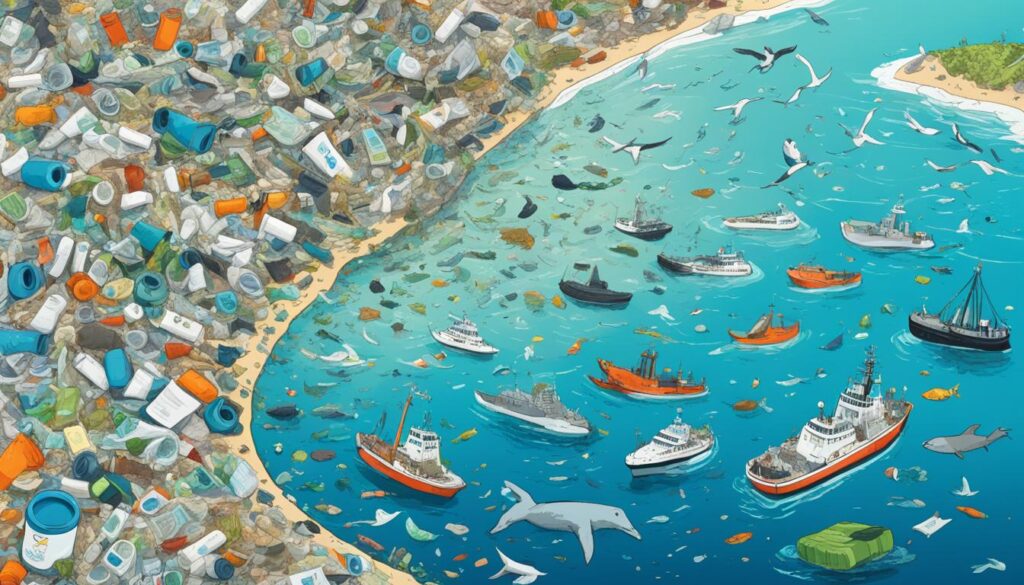
Myths and Misconceptions About Oceanic Trash Vortexes
The GPGP defies the common notion of an easily removable floating landfill. Instead, it comprises plastic debris of all sizes, from vast ghost nets to minuscule pieces, posing a grave threat to aquatic species, including albatrosses and sea turtles. Its existence is a dire warning, emphasizing the necessity for immediate action and sparking a movement toward reevaluating our use of single-use and disposable plastics.
| Statistic | Detail | Impact |
|---|---|---|
| Size of GPGP | 620,000 square miles | Extreme-scale complicates cleanup and illustrates the widespread issue |
| Marine Species Affected | 484 invertebrates across 46 species (2018-2019 study) | Indicates the diversity of life impacted by marine debris |
| Percentage of Coastal Species | 80% | A significant number of non-native species are transported by debris |
| Microplastics Predominance | 1.8 trillion pieces weighing 80,000 tonnes | Microplastics spread throughout the water column and marine food web |
| Global Plastic Production | 460 million tons annually | With rising production, conservation efforts are increasingly vital |
The enormity and intricacy of the Great Pacific Garbage Patch highlight the imperative for a comprehensive approach to environmental conservation and pollution alleviation. It serves as a clarion call for action to prevent the further accumulation of marine plastic pollution and to protect our marine ecosystems for future generations.
Dead Zones: Ocean Areas Devoid of Life
The escalating concern for ocean health illuminated the crisis called dead zones. These barren marine expanses underscore the gravity of marine life degradation. They starkly exhibit the ramifications of anthropogenic impacts on the planet’s aquatic environments.
How Nutrient Pollution Creates Marine Dead Zones
Nutrient pollution, primarily from agricultural effluents, is a principal catalyst for dead zones. The Mississippi River, funneling 41% of the United States’ drainage, discharges substantial nutrients into the Gulf of Mexico. This discharge engenders algal blooms and devours the oxygen crucial for marine life. Since 1985, research and documentation have revealed that escalated agricultural pursuits aimed to support an expanding global populace have exacerbated these conditions. Presently, initiatives toward sustainability hinge on advancing nutrient management strategies to mitigate this menace.
Reversibility of Dead Zones: Is There Hope?
Notwithstanding the pervasive proliferation of dead zones, optimism persists regarding their reversibility, contingent upon concerted sustainability efforts. Instruments such as the RESTORE Act and the Farm Bill play pivotal roles in safeguarding our ecosystems against nutrient pollution. Substantial reductions in nutrient runoff into the oceans can be achieved by reestablishing riverine connections to floodplains and optimizing soil management. Consequently, beleaguered regions may witness revival, flourishing anew.
| Statistic | Impact |
|---|---|
| 41% of the U.S. drained by the Mississippi River | Contributes significantly to the Gulf’s dead zone |
| Size of 2018 Gulf dead zone | Comparable to Delaware |
| Largest size recorded in 2002 | 22,000 square kilometers |
| Triple levels of dissolved nitrogen since 1960 | Increased algal growth and dead zone development |
| Over 400 dead zones worldwide | Suffocating marine life across oceans |
| Rate of dead zone doubling | Every decade globally |
How Human Activities Become Major Causes of Marine Pollution
The impact of ocean pollution is traced to an array of human activities leading to extensive environmental degradation. Coastal regions, previously unspoiled, now bear the weight of escalating pollutant loads. These originate predominantly from land, extending from adjacent coastal areas to remote inland locales. A thorough examination of the correlation between such practices and the marine ecosystem’s decline is essential for devising effective pollution prevention strategies.
A substantial fraction of marine pollutants are attributed to nonpoint source pollution. Daily human operations, including agricultural runoff, septic system malfunctions, and vehicular emissions, amalgamate into a hazardous concoction that ultimately percolates into the marine environment. Despite its dispersed origins, nonpoint source pollution conglomerates significantly threaten aquatic ecosystems.
On the contrary, point source pollution, evidenced by disastrous oil and chemical discharges, manifests with immediate and starkly evident detriments. While less frequent, the repercussions of such incidents are protracted, persisting over the years, and highlight the imperative for robust pollution prevention legislation.
| Source of Pollution | Impact on Ocean | Impact on Human Health |
|---|---|---|
| PFAS chemicals | Long-lasting environmental effect | Found in drinkable water, poses health risks |
| Excess nutrients | Initiates algal growths, hypoxia | Jeopardizes seafood safety |
| Marine debris (e.g., fishing gear) | Damages marine life and habitats | Builds up in seafood |
| Coastal pollution | Impacts over one-third of areas cultivating shellfish | Results in contaminated shellfish |
Human enterprises, notably expansive fisheries networks, significantly exacerbate the pollution dilemma, with mislaid or forsaken fishing equipment inflicting severe damage on marine environments and fauna. Furthermore, the presence of five vast ocean gyres gathers and concentrates marine debris into substantial garbage patches. This demonstrates a glaring inadequacy in waste management and consumption patterns.
Microplastics and heavy metals, despite their diminutive scale, pose a grave threat due to their propensity to bioaccumulate within the food web. This poses undeniable risks to human health, accentuating the global integral bond between oceanic vitality and community health.
NOAA’s Sustainable Seafood portal spearheads efforts in monitoring seafood contamination, providing directives to safeguard public health against the repercussions of pollution. This portal plays a pivotal role in guiding consumers towards choices that are both safe and sustainable regarding seafood consumption.
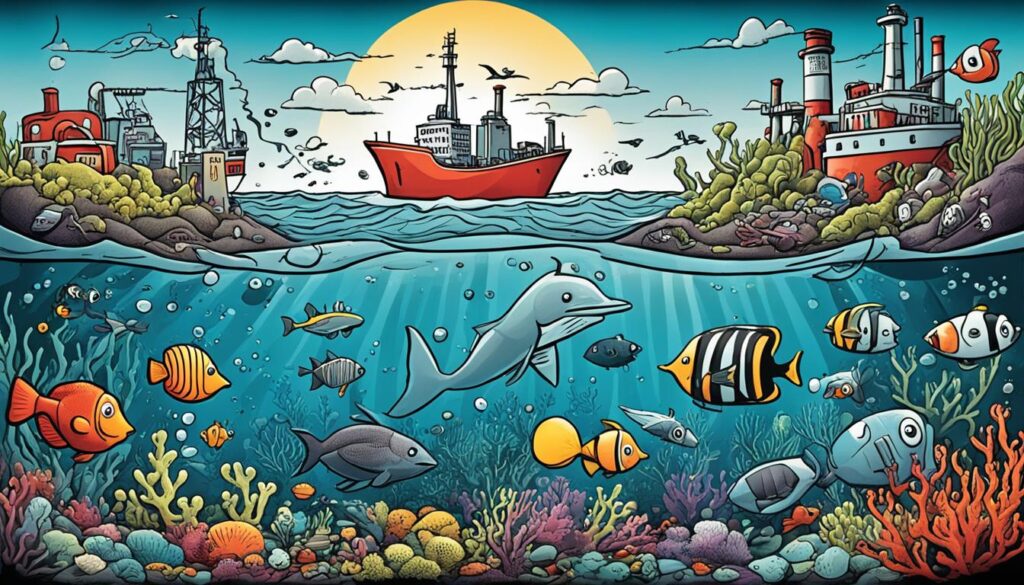
The legacy of human activities is indelibly inscribed upon the marine ecosystem. This necessitates an immediate reassessment of our practices and policy frameworks to alleviate the inflicted harm. Society is responsible for fostering a reciprocal relationship with marine environs, one that reveres the natural world and champions the cause of future generations.
The Impact of Ocean Pollution on Marine Life
Grasping the impact of ocean pollution on marine life is a cornerstone of devising robust conservation strategies. Human activities, both along coastlines and upstream, funnel pollutants, including PFAS, microplastics, and heavy metals, into marine environments. These toxic substances are implicated in several deleterious outcomes: hypoxia, harmful algal blooms, and bioaccumulation of toxins within the marine trophic levels. Such interactions undermine not only marine organism health but also the intricate equilibrium of marine biomes.
The spectrum of organisms imperiled by pollution extends from microscopic plankton to the apex marine mammals. Ocean debris, notably plastics, poses entanglement dangers, while microplastics and runoff pollutants threaten marine beings through ingestion, potentially leading to injury or mortality. The Pacific Garbage Patch exemplifies the enduring and extensive nature of the marine pollution crisis.
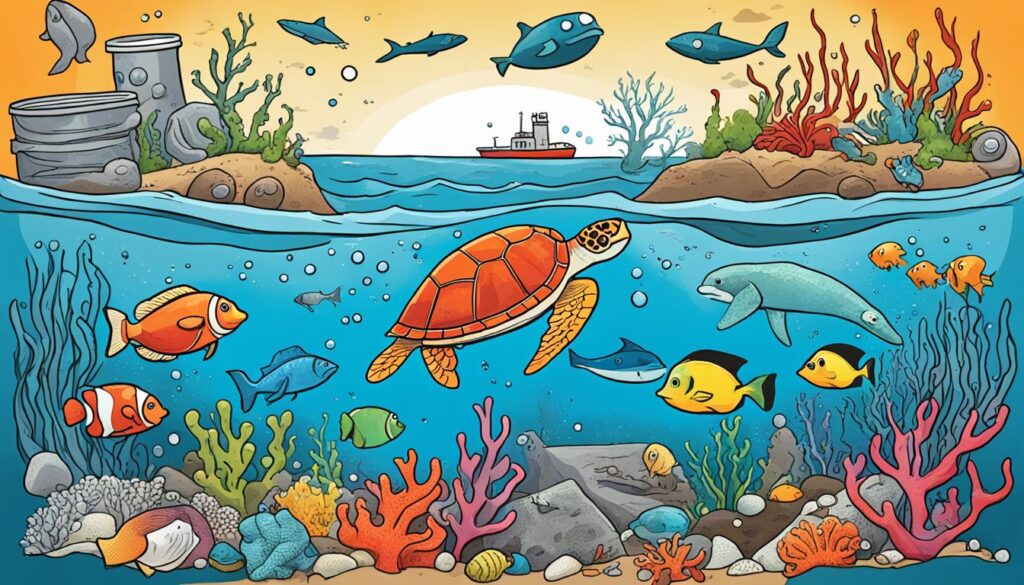
Moreover, the proliferation of dead zones and the diminishing populations of key species like shellfish, which now encounter hostile conditions in more than a third of their habitats due to pollution, underscore the severity of this issue. Educational efforts by entities such as NOAA are pivotal to pollution mitigation. Nonetheless, the continuous dumping of over 8 million tons of plastic into the oceans annually and the regular entanglements and strandings of marine animals, such as sea turtles, demand immediate global intervention.
| Statistic | Impact |
|---|---|
| 80% of marine debris originates on land | Introduction of pollutants into marine ecosystems |
| 1,000+ sea turtles stranded due to entanglement (1997–2009) | Indication of the threat fishing gear poses to marine life |
| 90% of seabirds have ingested plastic | Widespread ingestion of harmful debris among marine bird species |
Data poignantly illuminate the extensive ramifications of anthropogenic pollution on marine ecosystems, underscoring the imperative of embracing solutions like meticulous waste management and fisheries reform. While mechanisms such as the National Wildlife Refuge System are pivotal for marine conservation, the enduring challenge of marine debris reaffirms the crucial, ongoing battle to secure marine ecosystems against the encroachment of ocean pollution.
Ocean Contamination and Its Human Health Implications
The nexus between our marine environments and pollution gravely affects human well-being due to bioaccumulation’s insidious nature. Within this process, toxins infiltrate the food chain via smaller organisms, intensifying as they ascend the hierarchy, eventually permeating the seafood consumed by humans. Subsequently, individuals may encounter a spectrum of health disorders, including, but not limited to, acute poisoning, chronic diseases, cancer, and neurodevelopmental disorders.
The Dangers of Bioaccumulation and Toxins
Bioaccumulation signifies the accumulation of toxins in marine beings at a pace surpassing their elimination. As humans ingest contaminated seafood, they confront substances with the potential for profound health alterations. The ramifications of such toxin consumption mirror the enduring nature of pollutants, underscoring the imperative for staunch efforts toward oceanic preservation and bioaccumulation mitigation.
Protecting Ourselves and Future Generations From Contaminated Seafood
Assuming the mantle of guardians for both the environment and human well-being necessitates intensified initiatives. Initiatives must first acknowledge the significant role of terrestrial pollution sources—including runoff from automobiles, vessels, and agricultural activities—alongside the pervasive issue of microplastics. Advancing toward sustainable energy, enhancing waste management, and diminishing plastic reliance constitute pivotal steps that can engender meaningful environmental transformation.
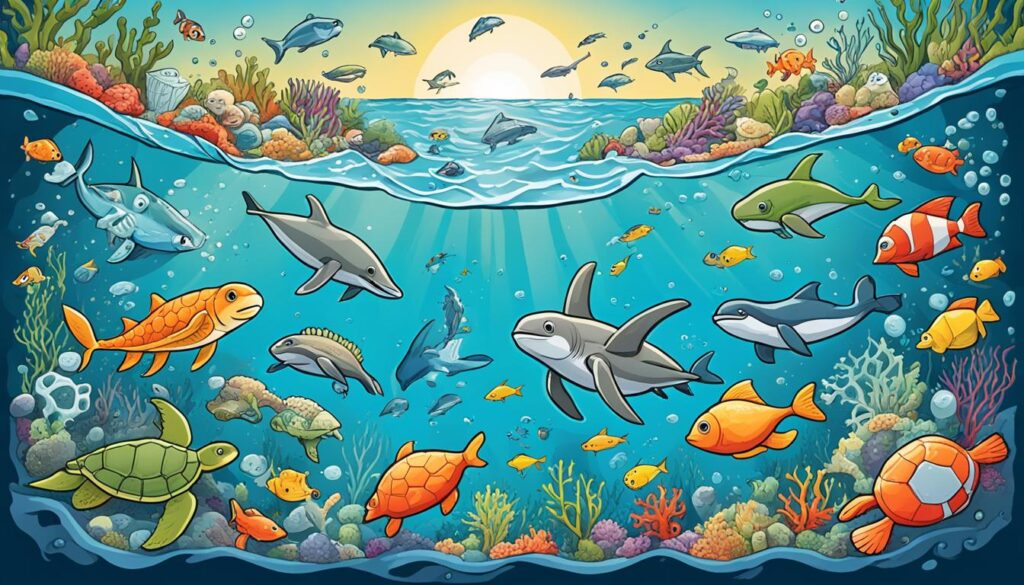
Statistics of Concern:
- Approximately 80% of marine pollution originates from land-based sources, with a significant portion comprising plastics and toxins.
- The infamous Pacific Garbage Patch covers an area of about 1.6 million square kilometers and serves as a stark reminder of human impact on the oceans.
- Billions of pounds of waste enter our oceans annually, exacerbating situations such as algal blooms, which harm marine life and jeopardize local fishing and tourism industries.
This clarion call to protect marine ecosystems reflects the profound linkage between the health of our oceans and the welfare of our communities. Every pollution-reducing measure has the potential to divert us from a future marred by contamination.
Table: Impact of Marine Debris on Human Health and Ecosystems
| Marine Pollution Source | Impact on Marine Ecosystem | Human Health Implications |
|---|---|---|
| Land-based waste (80%) | Disruption of habitats, death of marine life | Contamination of seafood, health risks |
| Microplastics & debris | Intake by marine species, lower oxygen levels | Potential for toxin accumulation in the body |
| Chemical pollutants | Altered acidity, algal blooms | Health issues in communities relying on seafood |
| Runoff from land | Carrying various pollutants to the ocean | Increased heavy metal and toxin exposure |
In conclusion, ecosystem interconnectedness mandates a unified global effort for pollution reduction. Harnessing collective strength, we have the potential to preserve ocean sanctity, ensuring the prosperity of marine life and, by extension, human existence for future generations. Ultimately, the well-being of marine species is synonymous with protecting human health.
Preventing Ocean Pollution: Strategies and Solutions
The global challenge of preventing ocean pollution necessitates the adoption of comprehensive solutions. It demands the engagement of individuals, corporations, and governments alike. With over 400 million tons of plastic produced annually and a recycling rate of less than 14% for plastic packaging, the urgency to advance sustainability and enact effective plastic pollution strategies is undeniable.
Reducing Chemical Fertilizers to Mitigate Nutrient Pollution
The environmental repercussions of nutrient pollution mandate a crucial reduction in chemical fertilizer usage. The overapplication of these substances causes hazardous runoff, propelling oceanic dead zones and diverse ecological catastrophes. This transition reinforces marine pollution mitigation efforts and calls for pivotal reforms within our agricultural methodologies.
Embracing Reusable Alternatives to Single-Use Plastics
Advocating for the elimination of single-use plastics is crucial to addressing the escalation of plastic waste. Simultaneously, promoting reusable alternatives emerges as paramount. This policy directly addresses ocean pollution prevention by significantly reducing the influx of disposable plastics into marine environments, which constitute approximately 90% of everyday plastic items. It epitomizes an essential chapter in individual and collective efforts towards enduring environmental sustainability.
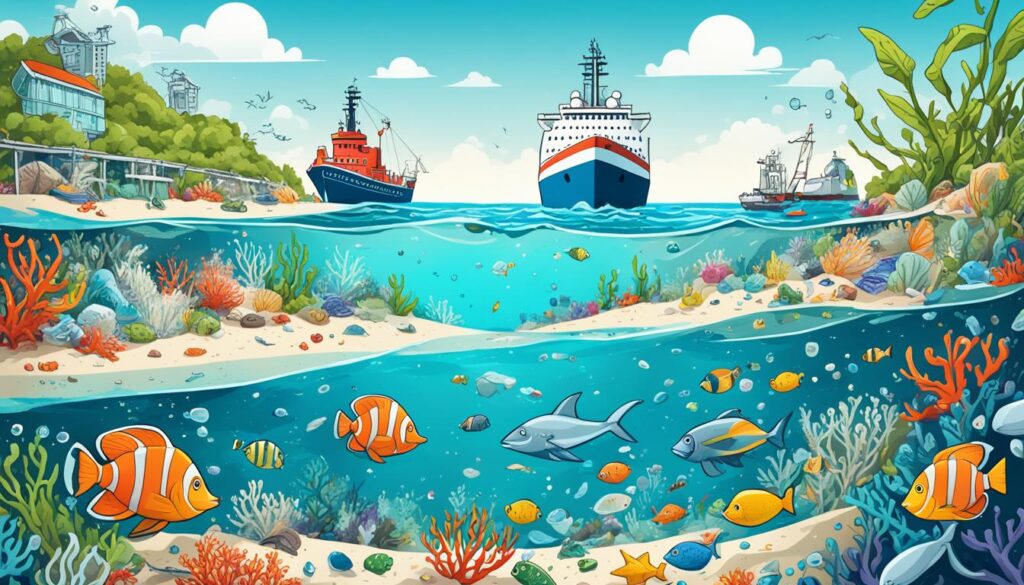
Key statistics underscore the gravity of our battle against marine pollution:
| Statistic | Impact on Ocean Pollution |
|---|---|
| 400 million tons of plastic produced annually | Contributes to the growing volume of marine litter |
| 14 million tons of plastic enter the ocean each year | Endangers marine wildlife and exacerbates the environmental ramifications of pollution |
| 80% of marine litter is plastic | Facilitates ingestion by marine life and the permeation of microplastics into the food web |
| Cities countering plastic bag usage | Diminishes plastic waste and champions the transition to reusable bags |
| Investments in improving waste collection in Southeast Asia | Addresses a significant origin of ocean plastic and bolsters circular economy initiatives |
The enactment of pollution solutions transcends the modification of personal habits; it necessitates the imposition of demands on manufacturers for packaging innovation and augments financial support for pertinent research. Through the earnest pursuit of sustainability and the proactive deterrence of marine pollution, we edge closer to securing a pristine and resilient marine ecosystem.
Improving Waste Management to Protect Our Oceans
Alarmingly, between 4 and 12 million metric tons of plastic waste are annually deposited into our oceans. These figures are expected to increase exponentially if unaddressed, posing a severe threat to marine ecosystems and biodiversity. It is crucial, therefore, to enhance our waste management strategies and intensify ocean cleanup efforts.
Global recycling initiatives fall short, with a mere 9% of plastic undergoing recycling, underscoring an urgent need to augment our recycling frameworks. The enactment of the 2021 Break Free From Plastic Pollution Act marks an essential stride toward mitigating the plastic pollution crisis. The consensus on a global plastics agreement by 175 nations further demonstrates a unified dedication to curtailing plastic dispersion.
Over half of the global sea turtle population and almost all seabird species consume plastic, which profoundly disrupts marine life equilibrium. Engaging with organizations like the Oceanic Society, Plastic Pollution Coalition, 5 Gyres, Algalita, and Plastic Soup Foundation will magnify our impact on solutions for ocean pollution.
Despite their diminutive size, microbeads have significantly contributed to ocean plastic pollution. Found extensively in cosmetic products, they persist in the ocean, necessitating urgent measures to prevent their introduction into marine habitats.
Enhancing the current recycling rate of 9% is imperative for aquatic conservation. Promoting superior waste management habits among the populace and developing cutting-edge recycling technologies are vital. Moreover, concerted ocean cleanup efforts should focus on eradicating microplastics to safeguard marine life continuity.
- Intensify recycling programs and infrastructure
- Endorse responsible disposal methods
- Back advancements in plastic waste treatment technologies
- Support legislation and global treaties to combat plastic pollution
- Champion the cause of nonprofit organizations working toward ocean health
- Reduce the use of products containing microbeads
Global Efforts and Sustainability: Progress in Ocean Conservation
The quest for ocean conservation has galvanized a spectrum of global efforts to nurture the sea’s delicate ecosystems for generations to come. Rising to this call, international agreements have seen signatory nations committing to significant reductions in disposable plastics, unveiling a crucial pivot towards sustainability and responsible stewardship of our planet’s waters. Furthermore, the boldest strides in environmental conservation can often be found in the innovations brought forth by solid plastic waste management strategies, which are key to deterring the relentless march of pollution into our oceans.
International Agreements and Ocean Pollution Solutions
In response to the mounting pressures of marine pollution, countries across the globe are coalescing under the banner of sustainability to establish and reinforce international treaties. These agreements are geared toward minimizing the adverse impacts of human activity on marine life, crafting a shared vision for a cleaner, more resilient oceanic environment. Such cooperation underscores the importance of environmental conservation and emphasizes the need for concerted action to protect our world’s watery realms.
Sustainable Practices and Innovations in Plastic Waste Management
With the U.S. Environmental Protection Agency (EPA) setting ambitious targets to boost the nation’s recycling rate to 50 percent by 2030 and promoting novel USDA-supported bioplastic research, the collective march towards a circular economy is gathering pace. Underpinning these initiatives are critical programs like the Trash Free Waters project and the Department of Energy (DOE)’s Plastics Innovation Challenge, which, together with the USDA and BSEE, reflect a multi-faceted approach to reducing plastic pollution and its associated greenhouse gas emissions. Such comprehensive strategies, along with the assistance provided by the FDA and innovative NASA-funded projects to detect microplastics, signal a robust framework taking shape—an infrastructure aimed squarely at ensuring the longevity and purity of our marine environments for posterity.
FAQ
What are the main types of ocean pollution?
How does plastic pollution affect marine life?
What are the most common plastic pollutants in the ocean?
What is nutrient pollution, and how does it impact the oceans?
What are the primary land-based sources of ocean pollution?
What are the effects of oil pollution on marine environments?
Besides plastics, what other types of marine debris contribute to ocean pollution?
What is the Great Pacific Garbage Patch, and why is it a concern?
Can ocean dead zones be reversed?
What human activities contribute to marine pollution?
How does ocean pollution impact human health?
What are some strategies to prevent ocean pollution?
How are global efforts contributing to ocean conservation?
Why is improving waste management essential for protecting the oceans?
What role do international agreements play in solving ocean pollution?
Source Links
- https://en.wikipedia.org/wiki/Marine_pollution
- https://www.noaa.gov/education/resource-collections/ocean-coasts/ocean-pollution
- https://www.nrdc.org/stories/ocean-pollution-dirty-facts
- https://www.iucn.org/resources/issues-brief/marine-plastic-pollution
- https://www.nrdc.org/stories/water-pollution-everything-you-need-know
- https://www.nationalgeographic.org/encyclopedia/marine-pollution/
- https://www.nationalgeographic.com/science/article/plastic-pollution-huge-problem-not-too-late-to-fix-it
- https://www.nps.gov/subjects/oceans/ocean-plastics.htm
- https://www.nationalgeographic.org/encyclopedia/great-pacific-garbage-patch/
- https://www.cnn.com/2023/04/17/world/plastic-pollution-ocean-ecosystems-intl-climate/index.html
- https://www.nature.org/en-us/about-us/where-we-work/priority-landscapes/gulf-of-mexico/stories-in-the-gulf-of-mexico/gulf-of-mexico-dead-zone/
- https://www.everycrsreport.com/reports/98-869.html
- https://www.nsf.gov/news/news_summ.jsp?cntn_id=115732
- https://www.doi.gov/ocl/marine-debris-impacts
- https://www.inspirecleanenergy.com/blog/clean-energy-101/causes-and-effects-of-ocean-pollution
- https://www.nrdc.org/stories/10-ways-reduce-plastic-pollution
- https://www.nationalgeographic.com/environment/article/ocean-plastic-pollution-solutions
- https://www.oceanicsociety.org/resources/7-ways-to-reduce-ocean-plastic-pollution-today/
- https://www.state.gov/u-s-actions-to-address-plastic-pollution/
